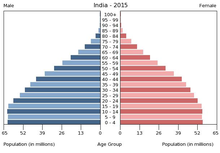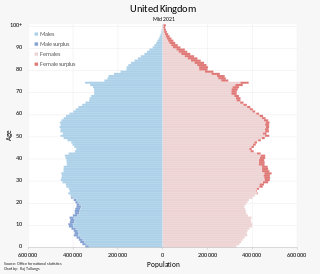
The population of the United Kingdom was estimated at over 67.0 million in 2020. It is the 21st most populated country in the world and has a population density of 270 people per square kilometre, with England having significantly greater density than Wales, Scotland, and Northern Ireland. Almost a third of the population lives in south east England, which is predominantly urban and suburban, with about 9 million in the capital city, London, whose population density is just over 5,200 per square kilometre.
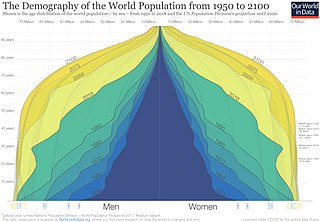
Demography, also known as Demographics, is the statistical study of populations, especially human beings.
In demography, demographic transition is a phenomenon and theory which refers to the historical shift from high birth rates and high death rates in societies with minimal technology, education and economic development, to low birth rates and low death rates in societies with advanced technology, education and economic development, as well as the stages between these two scenarios. In economic growth, the demographic transition has swept the world over the past two centuries,and the unprecedented population growth of the post-Malthusian period was reversed, reducing birth rates and population growth significantly in all regions of the world, and enabling economies to translate more of the gains of factor accumulation and technological progress into per capita income growth. The demographic transition strengthens economic growth process by three changes: (i) reduced dilution of capital and land stock, (ii) increased investment in human capital, and (iii) increased size of the labor force relative to the total population and changed age population distribution. Although this shift has occurred in many industrialized countries, the theory and model are frequently imprecise when applied to individual countries due to specific social, political and economic factors affecting particular populations.
Fertility is the ability to conceive a child. The fertility rate is the average number of children born during an individual's lifetime and is quantified demographically. Conversely, infertility is the difficulty or inability to reproduce naturally. In general, infertility is defined as not being able to conceive a child after one year of unprotected sex. Infertility is widespread, with fertility specialists available all over the world to assist parents and couples who experience difficulties conceiving a baby.

Birth rate, also known as natality, is the total number of live human births per 1,000 population for a given period divided by the length of the period in years. The number of live births is normally taken from a universal registration system for births; population counts from a census, and estimation through specialized demographic techniques. The birth rate is used to calculate population growth. The estimated average population may be taken as the mid-year population.
Zero population growth, sometimes abbreviated ZPG, is a condition of demographic balance where the number of people in a specified population neither grows nor declines; that is, the number of births plus in-migrants equals the number of deaths plus out-migrants. ZPG has been a prominent political movement since the 1960s.

The total fertility rate (TFR) of a population is the average number of children that would be born to a female over their lifetime if:
- they were to experience the exact current age-specific fertility rates (ASFRs) through their lifetime
- they were to live from birth until the end of their reproductive life.

Sub-replacement fertility is a total fertility rate (TFR) that leads to each new generation being less populous than the older, previous one in a given area. The United Nations Population Division defines sub-replacement fertility as any rate below approximately 2.1 children born per woman of childbearing age, but the threshold can be as high as 3.4 in some developing countries because of higher mortality rates. Taken globally, the total fertility rate at replacement was 2.33 children per woman in 2003. This can be "translated" as 2 children per woman to replace the parents, plus a "third of a child" to make up for the higher probability of males born and mortality prior to the end of a person's fertile life. In 2020, the average global fertility rate was around 2.4 children born per woman.
Population decline, also known as depopulation, is a reduction in a human population size. Throughout history, Earth's total human population has continued to grow; however, current projections suggest that this long-term trend of steady population growth may be coming to an end.

Population growth is the increase in the number of people in a population or dispersed group. Actual global human population growth amounts to around 83 million annually, or 1.1% per year. The global population has grown from 1 billion in 1800 to 7.9 billion in 2020. The UN projected population to keep growing, and estimates have put the total population at 8.6 billion by mid-2030, 9.8 billion by mid-2050 and 11.2 billion by 2100. However, some academics outside the UN have increasingly developed human population models that account for additional downward pressures on population growth; in such a scenario population would peak before 2100. Others have challenged many recent population projections as having underestimated population growth.

A population pyramid or "age-sex pyramid" is a graphical illustration of the distribution of a population by age groups and sex; it typically takes the shape of a pyramid when the population is growing. Males are usually shown on the left and females on the right, and they may be measured in absolute numbers or as a percentage of the total population. The pyramid can be used to visualize the age of a particular population. It is also used in ecology to determine the overall age distribution of a population; an indication of the reproductive capabilities and likelihood of the continuation of a species. Number of people per unit area of land is called population density.
Natural fertility is the fertility that exists without birth control. The control is the number of children birthed to the parents and is modified as the number of children reaches the maximum. Natural fertility tends to decrease as a society modernizes. Women in a pre-modernized society typically have given birth to a large number of children by the time they are 50 years old, while women in post-modernized society only bear a small number by the same age. However, during modernization natural fertility rises, before family planning is practiced.
Ansley Johnson Coale, was one of America's foremost demographers. A native to Baltimore, Maryland, he earned his Bachelor of Arts in 1939, his Master of Arts in 1941, and his Ph.D. in 1947, all at Princeton University. A long-term director of the Office of Population Research at Princeton, Coale was especially influential for his work on the demographic transition and for his leadership of the European Fertility Project.

The ageing of Europe, also known as the greying of Europe, is a demographic phenomenon in Europe characterised by a decrease in fertility, a decrease in mortality rate, and a higher life expectancy among European populations. Low birth rates and higher life expectancy contribute to the transformation of Europe's population pyramid shape. The most significant change is the transition towards a much older population structure, resulting in a decrease in the proportion of the working age while the number of the retired population increases. The total number of the older population is projected to increase greatly within the coming decades, with rising proportions of the post-war baby-boom generations reaching retirement. This will cause a high burden on the working age population as they provide for the increasing number of the older population.
In population ecology and demography, the net reproduction rate, R0, is the average number of offspring (often specifically daughters) that would be born to a female if she passed through her lifetime conforming to the age-specific fertility and mortality rates of a given year. This rate is similar to the gross reproduction rate but takes into account that some females will die before completing their childbearing years. An R0 of one means that each generation of mothers is having exactly enough daughters to replace themselves in the population. If the R0 is less than one, the reproductive performance of the population is below replacement level.
The gross reproduction rate (GRR) is the average number of daughters a woman would have if she survived all of her childbearing years, which is roughly to the age of 45, subject to the age-specific fertility rate and sex ratio at birth throughout that period. This rate is a measure of replacement fertility if mortality is not in the equation. It is often regarded as the extent to which the generation of daughters replaces the preceding generation of women and so on and so forth. If the value is equal to one that indicates that women will replace themselves. If the value is more than one that indicates that the next generation of women will outnumber the current one. If the value is less than one that indicates that the next generation of women will be less numerous than the current one.

Demographically, as in other more recent and thus better documented pre-modern societies, papyrus evidence from Roman Egypt suggests the demographic profile of the Roman Empire had high infant mortality, a low marriage age, and high fertility within marriage. Perhaps half of the Roman subjects died by the age of 5. Of those still alive at age 10, half would die by the age of 50.
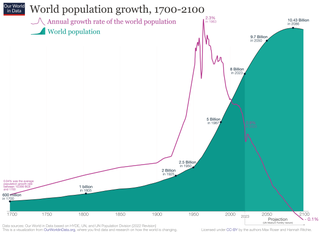
Population projections are attempts to show how the human population statistics might change in the future. These projections are an important input to forecasts of the population's impact on this planet and humanity's future well-being. Models of population growth take trends in human development and apply projections into the future. These models use trend-based-assumptions about how populations will respond to economic, social and technological forces to understand how they will affect fertility and mortality, and thus population growth.
Fertility factors are determinants of the number of children that an individual is likely to have. Fertility factors are mostly positive or negative correlations without certain causations.
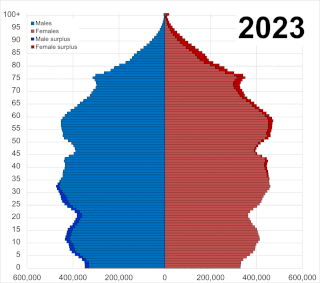
The population of the United Kingdom is getting increasingly older, due to longer life expectancy and a sub-replacement fertility rate for little under 50 years. The society is expected to change as a result culturally and economically. By 2050, 1 in every 4 people is expected to be above the age of 65 and this will be more extreme in certain areas of the country.
